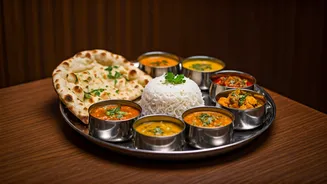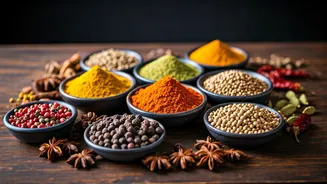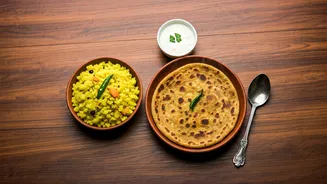North Indian Delights
North Indian cuisine is celebrated for its rich, creamy curries and tandoor-cooked specialties. Think of dishes like butter chicken, with its tender chicken pieces
swimming in a luscious tomato-based sauce, or the classic palak paneer, where fresh spinach and creamy paneer come together. The use of ghee (clarified butter) and a variety of warming spices like cumin, coriander, and garam masala is common. Tandoori dishes, cooked in a clay oven called a tandoor, have smoky flavors. Naan bread, with its soft, pillowy texture, is often served alongside these dishes, perfect for soaking up the flavorful curries. This region's food reflects the influence of Mughal rulers, known for their lavish feasts and culinary expertise. Meals often conclude with a sweet treat, such as gulab jamun or rasgulla, making North Indian food a satisfying and flavorful experience.
South Indian Flavors
South Indian cuisine features lighter, often vegetarian, dishes with a focus on rice, lentils, and fresh ingredients. The use of coconut, tamarind, and curry leaves gives this cuisine a distinctive taste. Dosa, a thin, crispy crepe made from fermented batter, is a popular breakfast choice, often served with sambar (a lentil-based vegetable stew) and chutney (a variety of sauces). Idli, soft, steamed rice cakes, are another staple breakfast food. The region's cuisine highlights the use of spices such as mustard seeds, turmeric, and asafoetida. Each state in South India has unique variations, showcasing a diverse culinary heritage. From the spicy Chettinad curries of Tamil Nadu to the seafood-rich dishes of Kerala, South Indian food presents a range of delightful tastes and textures, showcasing the region's abundant agriculture and coastal resources. The focus on fresh ingredients and simple cooking methods ensures that the natural flavors shine.
West Indian Specialities
West Indian cuisine showcases a unique blend of flavors, influenced by its coastal location and diverse communities. Maharashtra, Gujarat, and Goa each contribute unique specialties. Mumbai's street food, such as vada pav and pav bhaji, is legendary. Gujarat's thalis offer a variety of sweet and savory dishes, often vegetarian. Goa's cuisine is heavily influenced by Portuguese flavors, evident in dishes like vindaloo, a spicy pork stew, and seafood preparations with coconut milk and spices. The use of regional ingredients, such as kokum and tamarind, adds a distinctive tang. The cuisine reflects the trading history of the region, mixing local traditions with influences from various cultures. West Indian food highlights the use of a variety of spices, creating complex flavor profiles. This cuisine is known for its creativity and willingness to fuse various tastes, resulting in an exciting culinary experience.
East Indian Delicacies
East Indian cuisine, encompassing states like West Bengal, Bihar, and Odisha, often emphasizes seafood, rice, and lentils. Fish preparations, such as macher jhol, a light fish curry, and the use of mustard oil are common in Bengali cuisine. Bihar's cuisine often features sattu, a flour made from roasted chickpeas, and litti chokha, a baked wheat ball served with mashed vegetables. Odisha's cuisine incorporates a variety of seafood and unique sweets. The use of panch phoron, a blend of five spices, adds a distinctive flavor to many dishes. East Indian cuisine reflects the region's rivers, rice fields, and coastal areas, using fresh and local ingredients. The cooking methods are often simple, allowing the natural flavors to stand out. From the sweet treats of Bengal to the savory dishes of Bihar, East Indian cuisine provides a taste of the region's cultural richness and flavors, offering a balanced and enjoyable culinary experience.
Iconic Indian Dishes
Certain dishes have become synonymous with Indian cuisine globally, representing its diverse flavors. Butter chicken, with its rich, creamy sauce, is a North Indian favorite, beloved for its tender chicken pieces. Biryani, a fragrant rice dish with meat or vegetables, spices, and herbs, is prepared in different styles across India, each region bringing its unique touch. Dosa and idli, originating from South India, are globally appreciated for their unique textures and flavors. Samosas, deep-fried pastries filled with spiced potatoes, peas, and onions, are a common street food snack. The variety of dishes in India is vast and changes from region to region. These iconic dishes provide a delicious introduction to Indian cooking, symbolizing the country's rich culinary traditions and flavors. These dishes represent the best of Indian cooking and culture, providing something for every palate.
Regional Variations Galore
Regional variations are key to the charm of Indian cuisine, showcasing the diversity of its culinary traditions. Within North India, each state like Punjab, Kashmir, and Uttar Pradesh, has unique takes on staples like curries, breads, and meat preparations. South India showcases a range of flavors, from the spicy Chettinad curries of Tamil Nadu to the seafood-rich cuisine of Kerala and the use of dosas and idlis. In Western India, the blend of cultures in Maharashtra, Gujarat, and Goa offers diverse dishes like vada pav, Gujarati thalis, and Goan vindaloo. East Indian cuisine includes the fish curries of Bengal, the sattu-based dishes of Bihar, and the seafood specialties of Odisha. These variations reveal the true essence of Indian cooking. From the use of spices to the cooking methods, each region presents a unique culinary landscape. These variations highlight the richness and complexity of Indian cuisine, offering a vast array of flavors and cooking styles.












